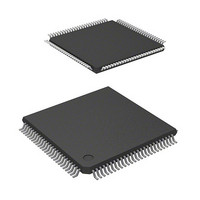DF2170BVTE33V Renesas Electronics America, DF2170BVTE33V Datasheet - Page 207

DF2170BVTE33V
Manufacturer Part Number
DF2170BVTE33V
Description
IC H8S/2170 MCU FLASH 100-TQFP
Manufacturer
Renesas Electronics America
Series
H8® H8S/2100r
Datasheet
1.DF2170BVTE33V.pdf
(572 pages)
Specifications of DF2170BVTE33V
Core Processor
H8S/2000
Core Size
16-Bit
Speed
33MHz
Connectivity
SCI, USB
Peripherals
DMA, POR, PWM, WDT
Number Of I /o
76
Program Memory Size
256KB (256K x 8)
Program Memory Type
FLASH
Ram Size
32K x 8
Voltage - Supply (vcc/vdd)
3 V ~ 3.6 V
Oscillator Type
External
Operating Temperature
-20°C ~ 75°C
Package / Case
100-TQFP, 100-VQFP
For Use With
HS0005KCU11H - EMULATOR E10A-USB H8S(X),SH2(A)3DK2166 - DEV EVAL KIT H8S/2166
Lead Free Status / RoHS Status
Lead free / RoHS Compliant
Eeprom Size
-
Data Converters
-
Available stocks
Company
Part Number
Manufacturer
Quantity
Price
Company:
Part Number:
DF2170BVTE33V
Manufacturer:
Renesas Electronics America
Quantity:
10 000
- Current page: 207 of 572
- Download datasheet (4Mb)
Single Address Mode: In single address mode, the DACK signal is used instead of the source or
destination address register to transfer data directly between an external device and external
memory. In this mode, the DMAC accesses the transfer source or transfer destination external
device by outputting the external I/O strobe signal (DACK), and at the same time accesses the
other external device in the transfer by outputting an address. In this way, DMA transfer can be
executed in one bus cycle. In the example of transfer between external memory and an external
device with DACK shown in figure 7.3, data is output to the data bus by the external device and
written to external memory in the same bus cycle.
The transfer direction, that is whether the external device with DACK is the transfer source or
transfer destination, can be specified with the SDIR bit in DMMDR. Transfer is performed from
the external memory (DMSAR) to the external device with DACK when SDIR = 0, and from the
external device with DACK to the external memory (DMDAR) when SDIR = 1.
The setting in the source or destination address register not used in the transfer is ignored.
The DACK pin becomes valid automatically when single address mode is selected.
The DACK pin is active-low. TEND pin output can be enabled or disabled by means of the
TENDE bit in DMMDR. TEND is output for one bus cycle.
Figure 7.3 shows the data flow in single address mode, and figure 7.4 shows an example of the
timing.
φ
Address bus
Figure 7.2 Example of Timing in Dual Address Mode
read cycle
DMSAR
DMA
write cycle
DMDAR
DMA
Rev. 2.00, 03/04, page 173 of 534
Related parts for DF2170BVTE33V
Image
Part Number
Description
Manufacturer
Datasheet
Request
R

Part Number:
Description:
KIT STARTER FOR M16C/29
Manufacturer:
Renesas Electronics America
Datasheet:

Part Number:
Description:
KIT STARTER FOR R8C/2D
Manufacturer:
Renesas Electronics America
Datasheet:

Part Number:
Description:
R0K33062P STARTER KIT
Manufacturer:
Renesas Electronics America
Datasheet:

Part Number:
Description:
KIT STARTER FOR R8C/23 E8A
Manufacturer:
Renesas Electronics America
Datasheet:

Part Number:
Description:
KIT STARTER FOR R8C/25
Manufacturer:
Renesas Electronics America
Datasheet:

Part Number:
Description:
KIT STARTER H8S2456 SHARPE DSPLY
Manufacturer:
Renesas Electronics America
Datasheet:

Part Number:
Description:
KIT STARTER FOR R8C38C
Manufacturer:
Renesas Electronics America
Datasheet:

Part Number:
Description:
KIT STARTER FOR R8C35C
Manufacturer:
Renesas Electronics America
Datasheet:

Part Number:
Description:
KIT STARTER FOR R8CL3AC+LCD APPS
Manufacturer:
Renesas Electronics America
Datasheet:

Part Number:
Description:
KIT STARTER FOR RX610
Manufacturer:
Renesas Electronics America
Datasheet:

Part Number:
Description:
KIT STARTER FOR R32C/118
Manufacturer:
Renesas Electronics America
Datasheet:

Part Number:
Description:
KIT DEV RSK-R8C/26-29
Manufacturer:
Renesas Electronics America
Datasheet:

Part Number:
Description:
KIT STARTER FOR SH7124
Manufacturer:
Renesas Electronics America
Datasheet:

Part Number:
Description:
KIT STARTER FOR H8SX/1622
Manufacturer:
Renesas Electronics America
Datasheet:

Part Number:
Description:
KIT DEV FOR SH7203
Manufacturer:
Renesas Electronics America
Datasheet:











